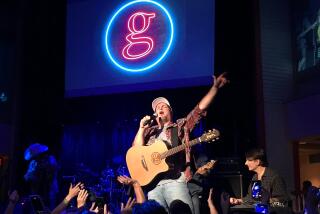Where Your Thirst Comes First
- Share via
TOMBSTONE, Ariz. — Legends die hard in the Old West. And out here in the San Pedro Hills I’ve found a beaut that passes the test of time. It’s called the Crystal Palace Saloon, and if you can find a finer drinking establishment anywhere on the Southwest frontier, I’ll buy you a double, straight up.
Mind you, I set tough standards. A good saloon is a place where the business of conversation and drinking is taken seriously, and both fellowship and aloneness are respected. It’s where the bartender is a fixture and everyone knows his first name, though not necessarily his last.
Good saloons pour honest drinks, run a tab and don’t have potted plants or young waiters who introduce themselves to the clientele.
When one of the actors in “Silverado” walked into a Western bar, sniffed the air and said gratefully, “I love the smell of a good saloon,” I knew just what he meant. A saloon should feel lived in, like a country kitchen. It should be alive with the buzz of voices and anticipation of important happenings, its ambiance a mixture of people and moods and mellowed woods, all of which have been around for a generation or more.
Long after the trendy places have come and gone, good saloons still stand, unchanged, on the same corners, because, after all, how do you improve on perfection?
Some Favorites
Duffy’s in Denver was always one of my favorites. So is Locke-Ober’s in Boston. You don’t see much Perrier sparkling water in these places and the food is hearty, bountiful and identified on the menus in simple English. San Francisco has countless fine saloons; Los Angeles has practically none.
But the real champion of Western saloon towns was, no doubt, Tombstone, which had 110 watering holes for its 10,000 thirsty citizens back in the days when the silver mines boomed and the Earps and the Clantons shot it out at the OK Corral.
The most famous of Tombstone’s establishments was the Crystal Palace, built in 1879 as the first two-story building in town. The mahogany bar, set on marble, ranged for 60 feet, the huge, arched mirrors rose nearly to the 20-foot ceiling and the faro tables spilled out into the floor.
Drinks cost 12.5 cents and the adjacent Golden Eagle Brewery promised to “deliver beer free anywhere in the village,” 10 gallons for $6.
Doc Holliday a Regular
Wyatt Earp used to play cards in the Palace and his brother, the city marshal, Virgil, had his office upstairs next to those of the coroner and the Cochise County sheriff.
Doc Holliday, a dentist dying of tuberculosis, was a regular, although his sometimes ladyfriend, Big Nose Kate, was barred by the Palace’s men-only policy. That policy was altered slightly when the proprietor finally agreed to hire a waitress, a woman nicknamed Apache Ann, a Jewish nurse from Cincinnati.
I walked through Tombstone (population 1,600) the other day, cut across the boardwalk on Allen Street, named for John (Pie) Allen, who made his grubstake selling pies to soldiers, entered the Crystal Palace and immediately fell in love.
I had stumbled into a gem, a saloon restored to its 1880s magnificence in every detail, right down to the “mustache napkins” hanging at intervals beneath the bar so customer could wipe beer foam from their beards.
One of the owners, the widow Betty Love, was at a table drinking a shandy gaff--beer and 7-Up (or Ginger Ale)--which, she explained, cleared the dust from one’s throat. Another owner, Wally Clayton, who labors over an old Royal manual typewriter as the editor of the Tombstone Epitaph next door, was nursing a vodka.
It was barely noon and the place was quiet, with only a few men at the long bar. They wore Stetsons and cowboy boots but there wasn’t a gun in sight.
Clayton, a one-time newspaper and advertising man from the East, and three others bought the Palace in 1964 when the saloon had fallen on tough times. The front booth was the Greyhound ticket office and a giant cooler with deli sandwiches ran along the wall where the faro tables once stood.
Help From ‘Fat Jack’
With the help of a Western historian at the University of Arizona, John (Fat Jack) Gilcriese, they restored the saloon exactly at a cost of $100,000. Craftsmen were found to rebuild the massive bar, a firm was hired to duplicate the original wallpaper, mirrors and marble were cut, red draperies hung. Only the spittoons went the way of time.
A lot of drinks have been poured in those 20 years and now the owners are ready to retire from the saloon business. The Crystal Palace is for sale for $500,000, about what the Lucky Cuss mine used to produce in silver in a good year of digging.
Any bill of sale will stipulate that the Palace continues to operate as it does today and did in the 1880s. That, says Clayton, means no food, no jukebox, no schlock. The ban on women, of course, no longer applies.
Although Tombstone was once the wildest of Western towns--Boot Hill Cemetery half a mile away remains a monument to death by stabbing, shooting, suicide and hanging--Clayton, a Western history buff, is quick to point out that the Palace was always a respectable saloon and never witnessed a shoot-out. Virgil Earp made sure the place stayed peaceful, just as his successor, Roy McNelly, does today.
‘Town Too Tough to Die’
McNelly wears a star on his leather vest, a .357 Magnum in a low-slung holster on his hip, a string tie and a black Stetson. He patrols the town in an ’81 LeBaron Chrysler, and Marshal McNelly sums up his life in “the town too tough to die” about the way Marshal Earp might have a hundred years ago.
“This is a good little community,” he says, “but every once in a while that full moon gets up there, and everyone goes a little wild. I didn’t use to believe in that moon stuff, but Tombstone’s made me a believer.”
The Crystal Palace is open daily from 10 a.m. to 10 or 11 p.m. on weekdays and until 1 a.m. on weekends. Drinks are about $2.
More to Read
Sign up for The Wild
We’ll help you find the best places to hike, bike and run, as well as the perfect silent spots for meditation and yoga.
You may occasionally receive promotional content from the Los Angeles Times.






